
The Lacertidae are the family of the wall lizards, true lizards, or sometimes simply lacertas, which are native to Afro-Eurasia. It is a diverse family with at least 300 species in 39 genera. They represent the dominant group of reptiles found in Europe. The group includes the genus Lacerta (genus), which contains some of the most commonly seen lizard species in Europe.
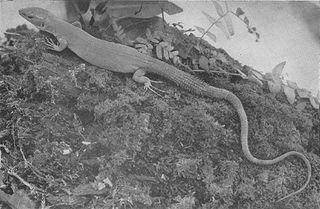
Gastropholis is a genus of Equatorial African lacertid lizards of the family Lacertidae which is distributed in southern Liberia, Ivory Coast and Ghana, western Cameroon, Equatorial Guinea, Democratic Republic of Congo, eastern Kenya, Tanzania and south to northeastern Mozambique.

Holaspis is a genus of equatorial African lizards in the family Lacertidae. These lizards are capable of gliding flight for distances of 30 meters.

Ichnotropis is a genus of African lizards in the family Lacertidae. Species in the genus Ichnotropis are commonly called rough-scaled lizards.
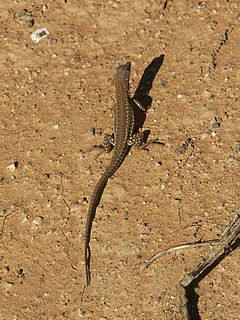
Meroles is a genus of lizards, commonly known as desert lizards, in the family Lacertidae. The genus contains eight species, inhabiting southwestern Africa, especially the Namib Desert.

Pseuderemias is a genus of lizards of the family Lacertidae. Common names for the genus are false sand lizards or racerunners.

The Indian fringe-fingered lizard, also known commonly as the Indian fringe-toed lizard, is a species of lizard in the family Lacertidae. The species is endemic to Asia.

Ophisops jerdonii, commonly known as Jerdon's cabrita, Jerdon's snake-eye, or Punjab snake-eyed lacerta, is a species of lacertid lizard, which is distributed in east Afghanistan, Pakistan, and India.
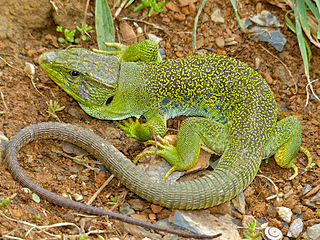
The ocellated lizard or jewelled lizard is a species of lizard in the family Lacertidae. The species is endemic to southwestern Europe.

Timon princeps, commonly called the Siirt lizard or the Zagrosian lizard, is a species of lizard in the family Lacertidae. The species is endemic to Western Asia.

The Gran Canaria giant lizard is a species of lizard in the family Lacertidae. The species is found in the Canary Islands.
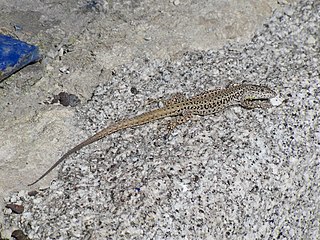
Podarcis vaucheri, the Andalusian wall lizard, is a species of lizard in the family Lacertidae. The species is native to northern Africa and southern Spain.

Bosc's fringe-toed lizard or Bosk's [sic] fringe-fingered lizard is a species of lizard in the family Lacertidae. The species is endemic to North Africa and Western Asia. Three subspecies are sometimes recognised; A. boskianus boskianus, from Lower Egypt; A. boskianus euphraticus from Iraq; and A. boskianus asper from the rest of the range; however this division is unsatisfactory because each subspecies has much variation and the differences between them are not consistent.

Nucras tessellata, also known as the western sandveld lizard, striped sandveld lizard, tiger lizard, striped sand lizard or banded sand lizard, is a species of lizard in the family Lacertidae. It is native to western Southern Africa and is found in western South Africa, southwestern Botswana, and southern and central Namibia north to Khomas Highland. Its range includes several protected areas, including Tankwa Karoo National Park and ǀAi-ǀAis/Richtersveld Transfrontier Park.

Ichnotropis capensis is a species of African lizard, which is native to the southern Afrotropics. It is the type species for the genus Ichnotropis, and is commonly called the Cape rough-scaled lizard due to them being found in southern Africa's Cape region. They are also called ornate rough-scaled lizard or Smith's rough-scaled sand lizard. The small lizards are terrestrial and occur in grassland, desert and brush areas of southern Africa.

Meroles squamulosa is a species of African lizard originally placed in the genus Ichnotropis, however phylogenetic evidence moves this species to the genus Meroles. The species is commonly called the common rough-scaled lizard or savanna lizard. It is largely found in southern Africa. These lizards are terrestrial and found in the range of mesic savannah. The common rough-scaled lizard is medium in size and well distributed in parts of Namibia, Botswana, Zimbabwe, Angola, Tanzania, and Zambia.
Ichnotropis microlepidota is a species of African lizard in the family Lacertidae. It is commonly called Marx's rough-scaled lizard and is largely found in Angola, Africa. I. microlepidota is a terrestrial lizard and was first discovered at the foot of Mount Moco.
Duméril's fringe-fingered lizard is a species of the genus fringe-fingered lizards in the Acanthodactylus scutellatus species group. It is found in the West and Central Sahara.
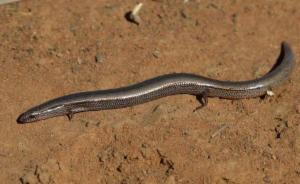
The dwarf three-toed slider or wood mulch-slider is a species of skink found in Australia. Other common names for the species include timid slider and dwarf burrowing skink. The skink is a member of the Lerista genus which are confined to continental Australia and are mostly a burrowing species of skink. The genus consists of consists elongated, smooth-scaled, Fossorial lizards that are specialized for life in the upper soils and dry leaf litter through which they slide using Lateral undulation as a form of locomotive action, giving rise to their nickname as sliders. They normally emerge of a night-time to hunt for small Invertebrates such as ants, termites and insects. If disturbed, they dive immediately into any loose substrate to avoid predation, this behavior leaves behind a distinctive disrupted wavy track that often found on sandy flats or dunes, roads and tracks.
















